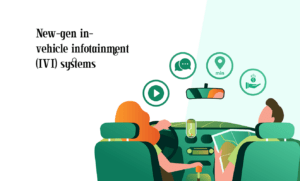The future of automotive technology is rapidly shifting and adapting to the ever-changing landscape. One of the biggest trends lately has been the implementation of connected car and in-car payment systems functionality. This technology has the potential to completely revolutionize the way we interact with our vehicles, as well as how we pay for goods and services while on the road. In this article, we’ll discuss what connected car and in-car payment systems are, why they’re important, and how you can implement them into your own vehicle. By the end, you should have a better understanding of how these technologies work and how they can benefit you.

New-gen in-vehicle infotainment (IVI) systems
IVI systems are the new generation of in-vehicle infotainment systems that offer a connected car experience. These systems offer a variety of features and services, including music and entertainment, navigation, communication, and even payments.
With so many features and services available, it can be difficult to know where to start when it comes to implementing them in your vehicle. However, there are a few key things to keep in mind that will make the process easier.
First, you need to consider what needs your IVI system will be fulfilling. Will it be used primarily for music and entertainment? Navigation? Communication? Once you know what needs the system will be filling, you can start looking at specific products and services that offer those features.
Next, you need to think about how you want to connect your IVI system to the rest of your vehicle. You\’ll need to consider things like whether you want wired or wireless connectivity, what sort of data plan you\’ll need (if any), and how you\’ll control the system. Again, thinking about your needs will help narrow down your options.
Finally, you need to budget for your IVI system. Pricing can vary widely depending on the features and services you choose, so it\’s important to set a budget before you start shopping around. Keep in mind that you may also need to purchase additional hardware like an antenna or mounting kit depending on your chosen system.
Automotive payment solutions functionality
When it comes to automotive payment solutions, there are a variety of different options and features that you can consider implementing. One of the most important things to keep in mind is what your customers want and need from such a system.
Some of the most popular automotive payment solutions functionality includes the ability to make payments for fuel, parking, and tolls directly from the car. This can be done via a connected smartphone or in-car display, making it quick and easy for drivers to settle up without having to fumble around with cash or cards.
Other popular features include the ability to track spending, set up recurring payments, and even receive discounts and rewards based on driving behavior. By offering a comprehensive and user-friendly solution, you can make life easier for your customers while also generating more revenue for your business.
In-car digital wallet
In-car digital wallet systems are one of the most promising new technologies for connected and automated vehicles. By allowing drivers to make payments directly from their cars, these systems have the potential to greatly reduce congestion and improve road safety.
However, implementing an in-car digital wallet system is not without its challenges. In order to be successful, such a system must be able to integrate with existing payment infrastructure and provide a user-friendly experience.
In this article, we will explore some of the key considerations for implementing an in-car digital wallet system. We will also provide an overview of how such a system might work in practice.
P2P Transfer
P2P Transfer is a technology that allows two devices to communicate with each other and transfer data between them. This can be used to transfer money, make payments, or even send messages.
This technology is already being used by some car manufacturers to allow cars to communicate with each other and exchange data. In the future, this could be used to allow cars to make payments to each other, or even send messages.
There are a few different ways that P2P Transfers can be used in cars. One way is for the car to have its own built-in P2P Transfer device. Another way is for the car to use a smartphone as a P2P Transfer device.
If you want to add P2P Transfers functionality to your car, there are a few things you need to do. First, you need to choose which method you want to use. Second, you need to install the appropriate software on your car. Third, you need to set up an account with a P2P Transfer provider.
Once you\’ve done all of this, you\’ll be able to use P2P Transfers in your car. You\’ll be able to make payments, send messages, and transfer data between devices.
Conclusion
In-car payment systems are a great way to make life easier for drivers and passengers. They can be used to pay for parking, gas, and other expenses. Connected car technology can be used to make payments even easier. With connected car technology, drivers can simply use their smartphones to make payments.
In order to implement in-car payment systems, there are a few things that need to be considered. First, the system needs to be able to accept various payment methods. Second, the system needs to be secure so that personal and financial information is protected. Third, the system should be easy to use so that drivers and passengers can easily pay for their expenses.